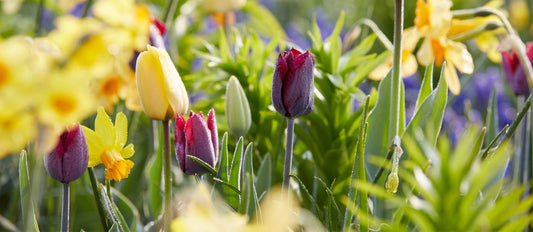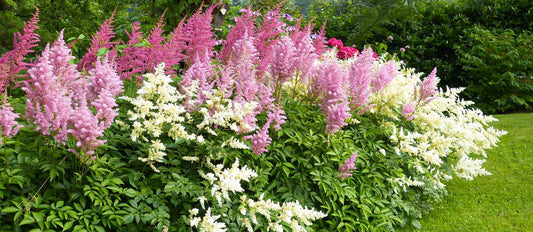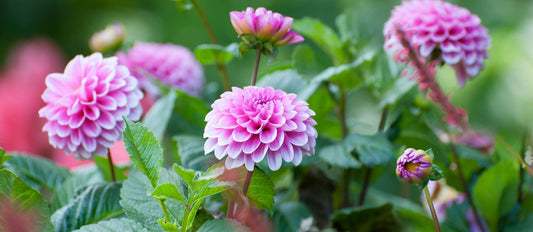Once the crocuses (crocus) start to flower, you know spring is just around the corner! A sunny day in February may still be winter, but all of a sudden they simply pop up out of the soil. Crocuses are extremely popular and come in many different colours; mainly yellow, white or purple, but some even have striped flowers. Catch the bug and let yourself be carried away by crocus fever!
Unusual crocus varieties
Unlike narcissi, crocuses are tubers rather than bulbs. Not all of crocuses flower in spring, as some varieties appear in the autumn. Plant these autumn crocuses as soon as you buy them, ideally before the end of September, and they won't be in the warm earth long before they come up. When it comes to spring-flowering crocuses, we distinguish between botanical varieties and large-flowered crocuses. Botanical crocuses have slightly smaller flowers and tend to start blooming in February, while large-flowered crocuses have larger flowers and tend to come out a bit later, in March.
Planting crocuses
You should plant crocuses between September and December. The best month for planting is different for each variety and depends on the temperature. Autumn-flowering crocuses should go in the ground as early as September, while you should plant spring-flowering crocuses between October and December, once the soil has lost its warmth. Whatever the variety, make sure that you plant them before the first frosts. Most varieties of crocus flower in February and March and some even last until April. Autumn crocuses flower in September/October, adding a splash of colour to what can be a grey season!
-
Planting in a border
So you can enjoy working in your garden between September and December, as long as the temperature is above freezing. Planting lots of crocuses together is extremely effective and you can plant around 200 to 300 tubers per square metre to create a huge explosion of colour If you want a more natural effect, scatter the tubers across the border and plant them where they land. Choose different varieties and colours to create variety in your garden. Of course, crocuses also look attractive in a lawn or adding a splash of colour under a tree or bush. They like to be in full sun and also respond to light, so the flowers will open when the sun is out and stay closed on cloudy days. If you want to plant crocuses underneath a tree, you therefore need to make sure that they will get enough light and that the soil you plant the tubers in is rich in nutrients, well-aerated and well-drained. If the soil is heavy, you can potentially add sand or grit to improve drainage. Dig a planting hole that is around three times the height of the tuber and wide enough that the roots won't get damaged. Place the tuber in the whole with its pointed end upwards and its roots on the soil. Fill the hole with fresh potting soil and tamp it down lightly. Water if the tubers have been dry for a long period. Protect any crocuses that have started to sprout once the frosts arrive.
-
Planting crocus tubers in a pot
You can also enjoy crocuses in a basket or pot on your patio or balcony, as well as in the open ground – again, make sure that you plant them before the first frosts. Make sure that you choose a decorative flower pot with enough room to space the plants out, so the roots don't destroy the other tubers as they grow. You can add organic fertiliser to the potting soil to make sure that the plants grow well. We recommend that you protect tubers in pots against hard frosts, by using bubble wrap, for example, or protective covers. you can also move the pots temporarily into your shed.
Looking after crocuses
Crocuses need very little looking after, although you can give them a little extra water during dry spells. Cover the tubers up once temperatures drop below freezing, so the frosts don't kill them. The tubers will often need some extra fertiliser once they have finished flowering, especially if the spring weather has been moderate for a long period.
If you have planted crocus tubers in your lawn, wait until the leaves have died back before you mow the grass.
Naturalising crocus tubers
Botanical crocuses are ideal for naturalising, where you leave the tubers to spread naturally. But you can give nature a bit of a helping hand as well. New small tubers will grow on the top of the crocus tuber using energy from the mother tuber. In autumn every year, once the crocuses have finished flowering, dig up a few baby tubers that have grown, divide them into smaller pieces and then plant these pieces in different spots in your garden. Repeat this several times to increase the number of new crocuses every year. The important thing is to remember to always leave the leaves alone after flowering.
If we've piqued your enthusiasm for planting crocuses or if you want to plant other flower bulbs or tubers in the autumn, take a look at our extensive range! Bakker.com has A-quality bulbs in the largest bulb size, which produced the biggest and strongest flowers. In addition, all our bulbs have the Holland Selection quality mark from the Stichting Kwaliteitskeurmerk foundation. This signifies that our flower bulbs and tubers are always healthy, so we can offer a 100% growth and flowering guarantee.







